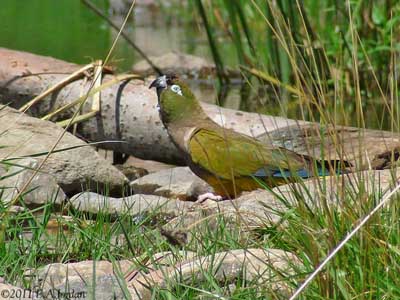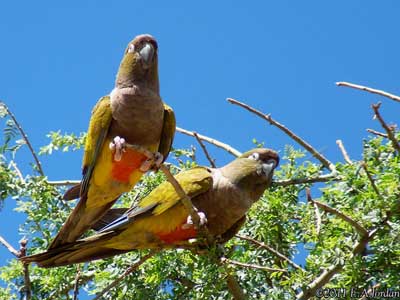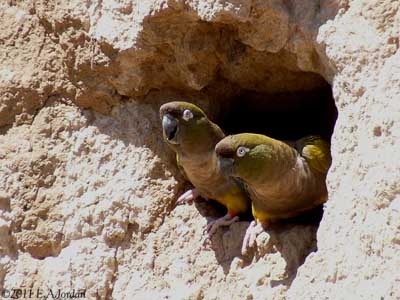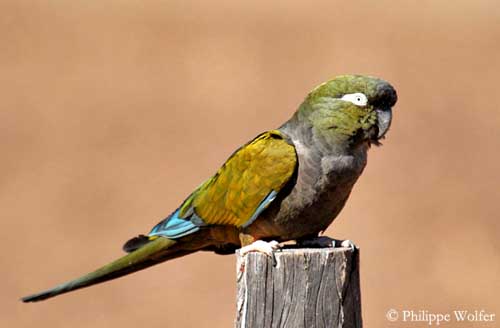
PROTECTION / THREATS / STATUS:
The Burrowing Parakeet is now patchily common. The populations decrease due to persecution as crop pest, illegal trapping for pet trade and loss of habitat and vegetation providing food. Disturbances by tourism on nesting grounds are also an important threat for the flightless chicks on the beaches.
Actions are in progress in order to designate the main colony of El Condor as Nature Reserve to protect the species.
Fr: Conure de Patagonie
All : Felsensittich
Esp : Loro Barranquero
Ital: Conuro della Patagonia
Nd: Holenparkiet
Photographers:
Eduardo Andrés Jordan
MIS AVES – AVES DE ARGENTINA
Philippe and Aline Wolfer
OISEAUX D’ARGENTINE
Text by Nicole Bouglouan
Sources :
HANDBOOK OF THE BIRDS OF THE WORLD vol 4 by Josep del Hoyo-Andrew Elliott-Jordi Sargatal - Lynx Edicions - ISBN: 8487334229
PARROTS OF THE WORLD – An Identification Guide – by Joseph M. Forshaw – Princeton University Press – ISBN 0691092516
BirdLife International (BirdLife International)
XENO-CANTO – Sharing Birds sounds from around the world
Burrowing Parakeet
Cyanoliseus patagonus
Psittaciforme Order – Psittacidae Family
BIOMETRICS:
Length: 45 cm
Weight: 256-280 g
DESCRIPTION:
The Burrowing Parakeet or Patagonian Conure was formerly common in Argentina. Today, these beautiful birds are extinct in some areas, due to persecution as crop pest, habitat loss and pet trade.
Adult has dull olive-brown head, neck, back and lower breast. The long tail is olive-green and conspicuously graduated. The upperwing shows greenish olive coverts, olive secondaries and bluish primaries.
The lower back, upper and undertail coverts, upper belly and flanks are yellow. Thighs and centre of belly are red-orange. Throat and upper breast are greyish-brown. We can see an indistinct patch on breast sides.
On the dull olive-brown head, the short hooked bill is grey. Eyes are whitish to pale yellow, surrounded by conspicuous bare white eye-ring. Legs and feet are pale pinkish.
Both sexes are similar.
The juvenile resembles adults with horn-coloured patch on the bill.

We can find four subspecies:
C.p. andinus from NW Argentina. This race is duller overall with less yellow on underparts.
C.p. conlara from WC Argentina. This one has darker breast.
C.p. patagonus from C to SE Argentina, occasionally migrating into Uruguay in winter.
C.p. bloxami from restricted range in C Chile. This race has brighter yellow underparts and more extensive whitish markings on the breast, forming broad breast band. This one is larger.
VOICE: SOUNDS BY XENO-CANTO
The Burrowing Parakeet utters guttural cry when perched. In flight, it gives shrill, noisy “scree-ah…scree-ah” audible at some distance. When at roost, the birds utter gull-like shrieks. The alarm call is “gyeee gyee gyeee”.
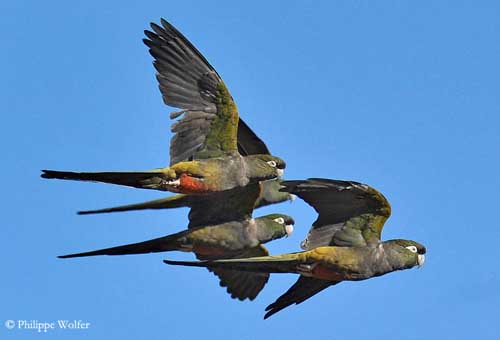
HABITAT:
The Burrowing Parakeet usually frequents open country near streams, arid lowland, montane grassy shrubland, open dry savannah with trees, thorny scrub and cacti with sandy soil, up to 2000 metres of elevation.
This bird can be seen in pastures and cultivated areas, and also in urban areas where groups roost on wires.
RANGE:
The Burrowing Parakeet is a South American species, found in Argentina, with a small isolated population in C Chile.
BEHAVIOUR:
The Burrowing Parakeet feeds on seeds taken from the ground and from the vegetation (in winter). It also consumes berries and fruits from several plant species.
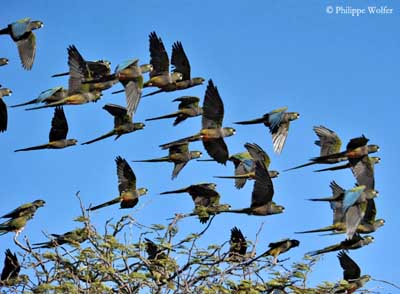
By day, the birds perform low flight, pausing briefly on low branches before to reach the ground to feed. The olive-brown plumage provides them good camouflage while foraging.
The Burrowing Parakeet is seasonal migrant in southern parts of the range. Populations of Central Chile perform altitudinal movements.
In other regions, the species is resident, with only local wandering according to the food resources.
FLIGHT:
The Burrowing Parakeet has direct flight, performing rhythmic shallow wing beats.

REPRODUCTION:
Breeding season occurs between September and February.
The Burrowing Parakeet nests in colonies in cliff-faces. The nest is a burrow excavated in sandstone or earth cliff, often along river or sea and at considerable height.
This species is monogamous with long pair-bonds. They excavate the burrows which often are interconnecting. The established pairs usually reuse the same burrow every year, while the new pairs must excavate a new one.
There is a tunnel of about 80-250 centimetres long; often in a zigzag, opening into the nest-chamber where the eggs are laid and the chicks raised.

Female lays 2-4 eggs and incubates alone during about 24 days. She is fed by the male during this period.
The nesting period lasts two months before the young leave the nest. They still depend on parents for several months more.
DIET:
The Burrowing Parakeet feeds mainly on seeds taken from the ground and from the vegetation, but it also consumes fruits and berries.
This species also takes grain crops, and is considered as crop pest, involving persecution from farmers.
